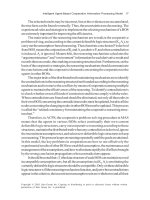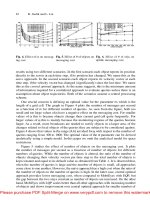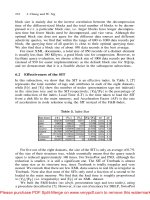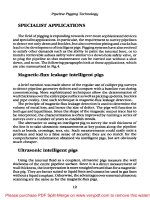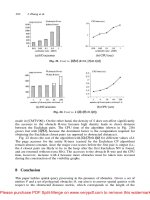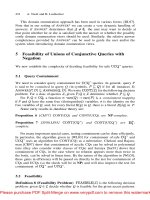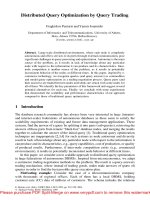5G Mobile Technology 2013 docx
Bạn đang xem bản rút gọn của tài liệu. Xem và tải ngay bản đầy đủ của tài liệu tại đây (726.31 KB, 27 trang )
5G Mobile Technology 2013
1
ACKNOWLEDGEMENT
I would like to express my sincere thanks to my guide and staff in charge, Dr : Devi.v
Professor, EEE department, for her vital support, valuable guidance and for providing me
with all facility and guidance for presenting assisting me in times of need.
I would also take this opportunity to express my heartfelt gratitude to Professor K I
GEETHA, Head of the Department of Electrical and Electronics Engineering, for her
valuable support and cooperation in the presentation of this paper.
I am thankful to my friends for their lively discussions and suggestions. Finally I
would like to thank the almighty who have given me all that is required for the successful
completion of my seminar.
5G Mobile Technology 2013
2
ABSTRACT
5G Technology stands for 5
th
generation mobile technology. 5G denote the next major
phase of mobile telecommunication standards beyond the upcoming 4G standards.
5G technology will change the way most high bandwidth users access their phones.
With 5G pushed over a VOIP enabled device, people will experience a level of call volume
and data transmission never experienced before. 5G technology is offering the service in
Product Engineering, Documentation, supporting electronic transactions, etc
As the customer become more and more aware of the mobile phone technology, he or
she will look for a decent package all together including all the advanced features a cellular
phone can have. Hence the search for new technology always the main motive of the leading
cell phone giants to out innovate their competitors. The goal of a 5G based
telecommunication network would ideally answer the challenges that a 4G model would
present once it has entered widespread use.
5G Mobile Technology 2013
3
CONTENTS
1. INTRODUCTION………………………………… ………………… 5
2. EVOLUTION FROM 1G TO 5G NETWORKS….………………………… 6
3. 1G WIRELESS SYSTEM………………………….…………………………….8
4. 2G WIRELESS SYSTEM ……………………………………….… 9
5. 3G WIRELESS SYSTEM ……………………………………………… …….10
6. 4G WIRELESS SYSTEM …………………………………………………… 11
7. WHAT IS 5G & WHAT IT OFFERS.……………………………………… …12
8. BASIC ARCHITECTURE OF 5G TECHNOLOGY…………………………….14
8.1. UBIQUITOUS COMPUTING…………………………………………14
8.2. AGGREGATOR……………………………………………………… 14
8.3. FLATTER IP CONCEPT………………………………………………15
9. 5G NANOCORE…………………………………………………………………16
9.1. NANOTECHNOLOGY……………………………………………… 17
9.2. NANO EQUIPMENT………………………………………………… 17
9.3. CLOUD COMPUTING……………………………………………… 18
9.4. ALL IP NETWORKS………………………………………………… 19
9.5. HETEROGENOUS WIRELESS NETWORKS ……………………….20
10. DESIGN OF 5G MOBILE NETWORK ARCHITECTURE………………… 22
11. BENEFITS OF 5G TECHNOLOGY……………………………………………23
12. CONCLUSION………………………………………………………………….24
13. ACRONYMS……………………………………………………………………25
14. REFERENCES………………………………………………………………… 27
5G Mobile Technology 2013
4
LIST OF FIGURES
1. 5G ARCHITECTURE………………………………………………………… ….16
2. SYSTEM MODEL FOR 5G ARCHITECTURE……………………………………23
5G Mobile Technology 2013
5
1.INTRODUCTION
The present cell phones have it all. Today phones have everything ranging from the
smallest size, largest phone memory, speed dialing, video player, audio player, and camera
and so on. Recently with the development of Pico nets and Bluetooth technology data sharing
has become a child's play. Earlier with the infrared feature you can share data within a line of
sight that means the two devices has to be aligned properly to transfer data, but in case of
blue tooth you can transfer data even when you have the cell phone in your pocket up to a
range of 50 meters. The creation and entry of 5G technology into the mobile market place
will launch a new revolution in the way international cellular plans are offered. The global
mobile phone is upon the cell phone market. Just around the corner, the newest 5G
technologies will hit the mobile market with phones used in China being able to access and
call locally phones in Germany.
Truly innovative technology changing the way mobile phones will be used. With the
emergence of cell phones, which are similar to a PDA, you can now have your whole office
within the phone. Cell phones will give tough competitions to laptop manufacturers and
normal computer designers. Even today there are phones with gigabytes of memory storage
and the latest operating systems .Thus one can say that with the current trends, the industry
has a real bright future if it can handle the best technologies and can produce affordable
handsets for its customers. Thus you will get all your desires unleashed in the near future
when these smart phones take over the market. 5G Network's router and switch technology
delivers Last Yard Connectivity between the Internet access provider and building occupants.
5G's technology intelligently distributes Internet access to individual nodes within the
building.
5G Mobile Technology 2013
6
2. EVOLUTION FROM 1G-5G NETWORKS
Cell phones are used millions and billions of users worldwide. How many of us know
the technology behind cell phones that is used for our communication? I have also intrigued
about the type of technology used in my phone. What are 1G, 2G, 3G and 4G technologies?
1G, 2G, 3G & 4G ("G" stands for "Generation") are the generations of wireless telecom
connectivity. In 1945, the zero generation (0G) of mobile telephones was introduced. Mobile
Telephone Service, were not officially categorized as mobile phones, since they did not
support the automatic change of channel frequency during calls. 1G (Time Division Multiple
Access and Frequency Division Multiple Access) was the initial wireless telecom network
system. It's out-dated now. The analog “brick phones” and “bag phones” are under 1G
technology. Cell phones era began with 1G.The next era, 2G has taken its place of 1G. Cell
phones received their first major upgrade when they went from 1G to 2G. This leap
effectively took cell phones from analog to digital. 2G and 2.5G were versions of the GSM
and CDMA connections. And GSM is still the most popular technology, but with no internet.
Fortunately, GPRS, an additional service, is provided over GSM for the purpose of internet
access. GPRS has been developed and thus, EGPRS was created. It's more secure and faster
than GPRS.
Then 3G came, the new Wireless CDMA technology. It is the first wireless telecom
technology that provides broadband-speed internet connection on mobile phones. It has been
specially made for the demand of internet on smart phones. Further development led to the
creation of 3.5G, which provides blazing fast internet connection on phones, up to the speed
of 7.2 MBPS. A smart phone can be connected to a PC to share its internet connection and
3G and 3.5G are ideal for this. But, as this WCDMA technology is not available in all
regions, its not as popular as GSM yet. Before making the major leap from 2G to 3G wireless
networks, the lesser-known 2.5G was an interim standard that bridged the gap. Following
2.5G, 3G ushered in faster data-transmission speeds so you could use your cell phone in more
data-demanding ways. This has meant streaming video (i.e. movie trailers and television),
audio and much more. Cell phone companies today are spending a lot of money to brand to
you the importance of their 3G network. The above systems and radio interfaces are based on
kindred spread spectrum radio transmission technology. While the GSM EDGE standard
5G Mobile Technology 2013
7
("2.9G"), DECT cordless phones and Mobile Wi MAX standards formally also fulfil the
IMT-2000 requirements and are approved as 3G standards by ITU, these are typically not
branded 3G, and are based on completely different technologies.
4G, which is also known as “beyond 3G” or “fourth-generation” cell phone
technology, refers to the entirely new evolution. Developers are now going for 4G
(OFDMA), which will provide internet up to the speed of 1 GBPS! It is said to be able to
overcome the problems of weak network strength and should provide a much wider network,
making sure that the users get high-speed connectivity anytime anywhere. No doubt, 4G will
open new doors of revolutionary internet technologies, but for now, 3G and 3.5G are the best.
4G will allow for speeds of up to 100Mbps. 4G promises voice, data and high-quality
multimedia in real-time form all the time and anywhere.
5G Mobile Technology 2013
8
3. 1G WIRELESS SYSTEM
First Generation wireless technology (1G) is the original analog(An analog or analogue signal
is any continuous signal for which the time varying feature (variable) of the signal is a
representation of some other time varying quantity), voice-only cellular telephone standard,
developed in the 1980s. The main difference between two succeeding mobile telephone
systems, 1G and 2G,is that the radio signals that 1G networks use are analog, while 2G
networks are digital. Although both systems use digital signalling to connect the radio towers
(which listen to the handsets) to the rest of the telephone system, the voice itself during a call
is encoded to digital signals in 2G whereas 1G is only modulated to higher frequency,
typically 150 MHz and up. One such standard is NMT (Nordic Mobile Telephone), used in
Nordic countries, Eastern Europe and Russia. Others include AMPS (Advanced Mobile
Phone System) used in the United States, TACS (Total Access Communications System) in
the United Kingdom, JTAGS in Japan, C-Netz in West Germany, Radio com 2000 in France,
and RTMI in Italy. Analog cellular service is being phased out in most places worldwide. 1G
technology replaced 0Gtechnology, which featured mobile radio telephones and such
technologies as Mobile Telephone System (MTS), Advanced Mobile Telephone System
(AMTS), Improved Mobile Telephone Service (IMTS), and Push to Talk (PTT)
Developed in 1980s and completed in early 1990’s
1G was old analog system and supported the 1st generation of analog cell phones
speed up to 2.4kbps
Advance mobile phone system (AMPS) was first launched by the US and is a 1G
mobile system
Allows users to make voice calls in 1 country
5G Mobile Technology 2013
9
4. 2G WIRELESS SYSTEM
2G is short for second-generation wireless telephone technology. Second generation
2G cellular telecom networks were commercially launched on the GSM standard in Finland
in 1991. 2G network allows for much greater penetration intensity. 2G technologies enabled
the various mobile phone networks to provide the services such as text messages, picture
messages and MMS (multimedia messages). 2G technology is more efficient. 2G technology
holds sufficient security for both the sender and the receiver. All text messages are digitally
encrypted. This digital encryption allows for the transfer of data in such a way that only the
intended receiver can receive and read it. Second generation technologies are either time
division multiple access (TDMA) or code division multiple access (CDMA). TDMA allows
for the division of signal into timeslots. CDMA allocates each user a special code to
communicate over a multiplex physical channel. Different TDMA technologies are GSM,
PDC, iDEN, IS-136. CDMA technology is IS-95. GSM has its origin from the Group special
Mobile, in Europe. GSM (Global system for mobile communication) is the most admired
standard of all the mobile technologies.
Although this technology originates from the Europe, but now it is used in more than
212 countries in the world. GSM technology was the first one to help establish international
roaming. This enabled the mobile subscribers to use their mobile phone connections in many
different countries of the world’s is based on digital signals ,unlike 1G technologies which
were used to transfer Analogue signals. GSM has enabled the users to make use of the short
message services (SMS) to any mobile network at any time. SMS is a cheap and easy way to
send a message to anyone, other than the voice call or conference. This technology is
beneficial to both the network operators and the ultimate users at the same time. In
comparison to 1G's analog signals, 2G's digital signals are very reliant on location and
proximity. If a 2G handset made a call far away from a cell tower, the digital signal may not
be enough to reach it. While a call made from a 1G handset had generally poor quality than
that of a 2G handset, it survived longer distances. This is due to the analog signal having a
smooth curve compared to the digital signal, which had a jagged, angular curve. As
conditions worsen, the quality of a call made from a 1G handset would gradually worsen, but
a call made from a 2Ghandset would fail completely. Data transfer in speeds is up to 64kbps.
5G Mobile Technology 2013
10
5. 3G WIRELESS SYSTEM
International Mobile Telecommunications-2000 (IMT 2000), better known as 3G or
3rdGeneration, is a generation of standards for mobile phones and mobile
telecommunications services fulfilling specifications by the International Telecommunication
Union. The use of 3G technology is also able to transmit packet switch data efficiently at
better and increased bandwidth. 3G mobile technologies proffers more advanced services to
mobile users. The spectral efficiency of 3G technology is better than 2G technologies.
Spectral efficiency is the measurement of rate of information transfer over any
communication system. 3G is also known as IMT-2000.
Transmission speeds from 125kbps to 2Mbps
In 2005, 3G is ready to live up to its performance in computer networking
(WCDMA,WLAN and Bluetooth) and mobile devices area (cell phone and GPS)
Data are sent through technology called packet switching
Voice calls are interpreted using circuit switching
Access to Global Roaming
Clarity in voice calls
Fast Communication, Internet, Mobile T.V, Video Conferencing, Video Calls, Multi
Media Messaging Service (MMS), 3D gaming, Multi-Gaming, etc. are also available
with3G phones.
5G Mobile Technology 2013
11
6. 4G WIRELESS SYSTEM
4G refers to the fourth generation of cellular wireless standards. It is a successor to 3G
and 2G families of standards. The nomenclature of the generations generally refers to a
change in the fundamental nature of the service, non-backwards compatible transmission
technology, and new frequency bands.3G technologies make use of TDMA and CDMA. 3G
(Third Generation Technology) technologies make use of value added services like mobile
television, GPS (global positioning system) and video conferencing.
The basic feature of 3G Technology (Third Generation Technology) is fast data
transfer rates. However this feature is not currently working properly because, ITU 200 is still
making decision to fix the data rates. It is expected that 2 Mbit/sec for stationary users, while
348 Kbits when moving or travelling. ITU sell various frequency rates in order to make use
of broadband technologies. Network authentication has won the trust of users, because the
user can rely on its network as a reliable source of transferring data.3G technology is much
flexible, because it is able to support the 5 major radio technologies. These radio technologies
operate under CDMA, TDMA and FDMA.CDMA holds for IMT-DS (direct spread), IMT-
MC (multi carrier). TDMA accounts for IMT-TC (time code), IMT-SC (single carrier).
FDMA has only one radio interface known as IMT-FC or frequency code. Third generation
technology is really affordable due to the agreement of industry. This agreement took place in
order to increase its adoption by the users. 3G (Third Generation Technology) system is
compatible to work with the 2G technologies. 3G (Third Generation Technology)
technologies holds the vision that they should be expandable on demand. The aim of the 3G
(Third Generation Technology) is to allow for more coverage and growth with minimum
investment. The bandwidth and location information available to 3G devices gives rise to
applications not previously available to mobile phone users.
Mobile TV- a provider redirects a TV channel directly to the subscriber's phone where
it can be watched.
Video on demand- a provider sends a movie to the subscriber's phone.
Video conferencing- subscribers can see as well as talk to each other.
Tele-medicine a medical provider monitors or provides advice to the potentially
isolated subscriber.
Mobile ultra-broadband(gigabit speed) access and multi-carrier transmission.
5G Mobile Technology 2013
12
7. WHAT IS 5G & WHAT IT OFFERS
5G Technology stands for 5th Generation Mobile technology. 5G technology has
changed the means to use cell phones within very high bandwidth. User never experienced
ever before such a high value technology. The 5G technologies include all type of advanced
features which makes 5G technology most powerful and in huge demand in near future.
The gigantic array of innovative technology being built into new cell phones is
stunning. 5G technologies which are on hand held phone offering more power and features
than at least 1000 lunar modules. A user can also hook their 5Gtechnology cell phone with
their Laptop to get broadband internet access. 5G technology including camera, MP3
recording, video player, large phone memory, dialling speed, audio player and much more
you never imagine. For children rocking fun Bluetooth technology and Pico nets has become
in market.
As per the present status all over the world WCDMA is commercially launched .Some
nations has planned to launch LTE within next quarter. Operator is looking ahead for wide-
scale deployment of LTE in 2012. Operators will also find that the timing is right to make the
switch because much of the first generation of 3G equipment will need to be upgraded soon.
LTE networking equipment and handsets, already under development, will become available
in 2010, and should be rolled out in large quantities in Europe by 2012. clearly shows that
within 2020 LTE will become the latest trend for wireless communication all over the world.
But yet our question remains unanswered. Why there is a need for 5G.
Even though LTE provides wide range of growth for present wireless
telecommunication. People are not in a circumstance to make use of those benefits in an
effective manner LTE might be rigorously used in Commercial/Industrial areas. But think of
a common man who utmost utilize LTE for downloading a movie or make a video call. Fact
is that there is no such ground-breaking application exists in real world to be utilized by a
common man. You might doubt how this verdict is applicable for current innovative world,
where have enormous splendid real time applications. Concern is that our present wireless
telecommunications is bottlenecked to use those applications in an effective manner. This
paper mainly focuses on how a 5G network can provide more approach to a common man to
utilize his available possessions in an immense way to make him to feel the real progress.
5G Mobile Technology 2013
13
If you can able to pay all your bills in a single payment with your mobile.
If you can able to sense Tsunami/earthquake before it occurs.
If you can able to visualize lively all planets and Universe.
We can lock our Laptop, car, Bike using our mobile when you forgot to do so.
Our mobile can share your work load.
5G Mobile can identify the best server.
Mobile can perform Radio resource management.
If your mobile can intimate you before the call drops.
Mobile phone get cleaned by its own. Can able to fold your mobile as per your desire.
If you can able to expand your coverage using your mobile phones.
If you can able identify your stolen mobile with nanoseconds.
If you can able to access your office desktop by being at your bedroom.
Mobile can able to suggest you possible medicine as per your healthiness.
Mobile can estimate the quality of your new build house.
Mobile can able to provide recent worth on products using its barcode.
5G Mobile Technology 2013
14
8. BASIC ARCHITECTURE OF 5G TECHNOLOGY
8.1. Ubiquitous Computing
5G would be about "ubiquitous computing", that is, having the ability to access the
applications want from any platform, anywhere, any time. To create such an environment,
one needs to integrate various applications, emerging from various engineering practices.
Human life will be surrounded by intelligent sensors, which will bring radical change to
human life’s daily approaches of doing things, as:
Your intelligent car will send SMS to your cell phone, from your car.
Your home security camera is attached to secured internet. So that you can view your
sitting room on your laptop/mobile phone screen, by accessing secure website.
You are receiving regular MMS from your hospital about your medication need and
next doctor appointment.
8.2. Aggregator
Existing telecom networks are fashioned in hierarchical way, where subscriber traffic
is aggregated at aggregation point (BSC/RNC) and then routed to gateways. (As shown in
figure).Flat IP architecture will lessen burden on aggregation point and traffic will directly
move from Base station to Media gateways. Vision of Super Core is based on IP platform.
All network operators (GSM, CDMA, Wimax, and Wireline) can be connected to one Super
core with massive capacity. This is realization of single network infrastructure. The concept
of super core will eliminate all interconnecting charges and complexities, which is right now
network operator is facing. It will also reduce number of network entities in end to end
connection, thus reducing latency considerably.
5G Mobile Technology 2013
15
8.3. Flatter IP concept
At regular interval, semiconductor manufacturers advance to a new generation with
smaller feature sizes. This allows them to incorporate more functions into a given area of
silicon and, hence, more features or new capabilities into electronic devices like cell phones,
Increased processing capacity will be allow Mobile devices (cell phones, PDAs, etc) to do
more tasks (instructions per minute) then before. This will lead to even the Flatter IP
network. As Flat IP has shifted some of the BSC/RNC’s radio resource functions to Base
station, Flatter IP will shift some of the RR functions, to Mobile devices from Base station.
Finally your cell phone will not be just access device but, it will also perform some of the
Radio Resource Management functions.
With the shift to flat IP architectures, mobile operators can
Reduce the number of network elements in the data path to lower operations costs
and capital expenditure.
Partially decouple the cost of delivering service from the volume of data transmitted
to align infrastructure capabilities with emerging application requirements.
Minimize system latency and enable applications with a lower tolerance for delay;
upcoming latency enhancements on the radio link can also be fully realized.
Evolve radio access and packet core networks independently of each other to a
greater extent than in the past, creating greater flexibility in network planning and
deployment.
Develop a flexible core network that can serve as the basis for service innovation
across both mobile and generic IP access networks.
Create a platform that will enable mobile broadband operators to be competitive,
from a price/performance perspective, with wired networks.
5G Mobile Technology 2013
16
9. 5G : Nano Core
Fig 1
Sophisticated technology has enabled an age of globalization. Technological
convergence is the tendency for different technological systems to evolve towards performing
similar tasks. What Nicholas Negroponte labelled the transformation of "atoms to bits," the
digitization of all media content. When words, images and sounds are transformed into digital
information, it expands the potential relationships between them and enable them to flow
across platforms.
5G Mobile Technology 2013
17
The 5G Nancore is a convergence of below mention technologies. These technologies have
their own impact on exiting wireless network which makes them in to 5G.
• Nanotechnology.
• Cloud Computing.
• All IP Platform.
9.1. Nanotechnology:
Nanotechnology is the application of Nano science to control process on nanometer
scale. i.e. between 0.1 and 100nm.The field is also known as molecular nanotechnology
(MNT). MNT deals with control of the structure of matter based on atom-by-atom and
molecule by molecule engineering. The term nanotechnology was introduced by Nori
Taniguchi in 1974 at the Tokyo international conference on production engineering.
Nanotechnology is the next industrial revolution, and the telecommunications industry will be
radically transformed by it in a few years. Nanotechnology has shown its impact on both
mobile as well as the core network. Apart from this it has its own impact on sensor as well as
security. This is considered as a most significant in telecommunication. We will be
discussing the same in our further slides.
9.2. Nano Equipment (NE):
Mobile phone has become more than a communication device in modern world it has
turned into an identity of an individual. In 5G Nanocore these mobile are referred as Nano
Equipment as they are geared up with nanotechnology. One of the central visions of the
wireless industry aims at ambient intelligence: computation and communication always
available and ready to serve the user in an intelligent way. This requires that the devices are
Mobile. Mobile devices together with the intelligence that will be embedded in human
environments – home, office, public places – will create a new platform that enables
ubiquitous sensing, computing, and communication
5G Mobile Technology 2013
18
Specifications of Nano Equipment are given as follow:
• Self Cleaning – the phone cleans by itself
• Self powered – the phone derives its energy/power from the sun, water, or air.
• Sense the environment – the phone will tell you the weather, the amount of air pollution
present, etc.
• Flexible – bend but not break
• Transparent – “see through” phones
9.3. Cloud Computing:
Cloud computing is a technology that uses the internet and central remote server to
maintain data and applications. In 5G network this central remote server will be our content
provider. Cloud computing allows consumers and business to use applications without
installation and access their personal files at any computer with internet access. The same
concept is going to be used in Nanocore where the user tries to access his private account
form a global content provider through Nanocore in form of cloud. The development of cloud
computing provides operators with tremendous opportunities. Since cloud computing relies
on the networks, it shows the significance of networks and promotes network development. It
also requires secure and reliable service providers, capabilities that operators have deep
expertise in. Operators can enter the cloud computing market and create new value-added
services and experiences by integrating industry content and applications in the digital
supermarket model.
This could make our user to obtain much more real-time application to utilize his 5G
network efficiently. Secure and reliable service can be provided with the help of quantum
cryptography. Cloud computing customer avoids capital expenditure for the Nanocore
thereby also reducing the cost of purchasing physical infrastructure by renting the usage from
a third party Provider(Content Provider). The Nanocore devours the resources and pay for
what it uses.
5G Mobile Technology 2013
19
Segments of Cloud Computing:
Cloud computing has three main segments which are as follows:
1. Applications – It is based on, on demand software services. On demand software
services come in different varieties. They vary in their pricing scheme and how the
software is delivered to the end users. In the past, the end-user would purchase a
server that can be accessed by the end user over the internet.
2. Platform - The platform segment of cloud computing refers to products that are used
to deploy internet. Net Suite, Amazon, Google, and Microsoft have also developed
platforms that allow users to access applications from centralized servers. Google, Net
Suite, Rack space cloud, amazon.com and sales force are some of the active
3. Infrastructure – The third segment in cloud computing, known as the infrastructure, is
the backbone of the entire concept. Infrastructure vendorsG environments such as
Google gears allow users to build applications. Cloud storage, such as Amazon’s S3,
is also considered to be part of the infrastructure segment.
5G Nanocore will efficiently utilizes all the above 3 segments to satisfy his customer
demands. The concept of cloud computing will reduce the CAPEX of 5G network
deployment. In turn this will create a less billing to the end user for all kinds of services that
he utilizes through Nanocore.
9.4. All IP Network:
As already discussed for converging different technologies to form a single 5G
Nanocore, We require a common platform to interact, Flat IP architecture act as an essential
part of 5G network. The All-IP Network (AIPN) is an evolution of the 3GPP system to meet
the increasing demands of the mobile telecommunications market. To meets customer
demand for real-time data applications delivered over mobile broadband networks, wireless
operators are turning to flat IP network architectures. Primarily focused upon enhancements
of packet switched technology, AIPN provides a continued evolution and optimization of the
system concept in order to provide a competitive edge in terms of both performance and cost.
5G Mobile Technology 2013
20
The key benefits of flat IP architectures are:
• Lower costs
• Universal seamless access
• Improved user experience
• Reduced system latency
• Decoupled radio access and core network evolution
The drive to all IP-based services is placing stringent performance demands on IP-
based equipment and devices, which in turn is growing demand for multicore technology.
There is strong growing demand for advanced telecommunications services on wired and
wireless Next Generation Network (NGN) infrastructures, and fast growing demand for the
same in the enterprise too. Within a few years, more than 10 billion fixed and mobile devices
will be connected via the Internet to add to the more than one billion already connected. All
these services are going to be deployed over full IP-based architecture.
9.5. Heterogeneous Wireless Networks Interoperability
The challenge in the design of the terminals is connected to the management of trade
between the flexibility of how to use the spectrum and needed space and power to given
platform. New methods for partial reconfigurable offer design dimensions that allow the
system to adapt to the opportunities and requirements of the terminals in a manner that shall
maximize the spectral efficiency and also maximize the battery power. As a result of growing
level of acceptance of the wireless technologies in different fields, challenges and types of
wireless systems associated with them are changing. In heterogeneous wireless networks the
concept is "always best connected" (always associated with the best quality), aimed at client
terminals, and is proposed in different researches.
Reviewing the concept of heterogeneous networks inevitably raises the question of
inter-working among the radio access technologies in a newly designed system, which will
not demand changes in the RATs, but only introduction of control functionalities the core
networks. In terms of the user or user applications, heterogeneous system or a heterogeneous
network is considered as a unified network and access a single segment which will place the
connection with the application servers in and out of operator’s network. To meet the relevant
5G Mobile Technology 2013
21
requirements of the user applications are generally considered two possible models for
interoperability between building blocks of radio access technologies within the
heterogeneous system. First one refers to a centralized operator access, while the second one
defines the Internet model of interoperability. The first model involves introducing a certain
level of integration between the radio access technology through which mobile access
terminal, in this direction have been made different analysis and developed different
standards that should define the levels of architecture connectivity for realizing vertical
handover between different access technologies involved in the construction of
heterogeneous domain. The introduction of this model implies interoperability protocol
interoperability of lower levels of communication in the field of radio access. The second
model is called the Internet model, which represents a focus for further development in this
paper and refers to providing continuity of customer service in case of independent radio
access technologies available to the mobile terminal by connecting on the network level. In
this case, interoperability between network technologies is done on the upper (network)
protocol levels, i.e. at a level that is common to all access technologies for communication
between user applications with the appropriate application servers. The ultimate goal of both
models for interoperability is the same and it is providing a transparent transfer of user
information between client applications and related application servers without impact on the
diversity of access technologies in the communication process and providing continuity of
user sessions in the communication process. The main difference between the two models
concerns the way in providing interoperability. Apart from this difference, very important are
vertical handover between access technologies and the conditions or circumstances which
trigger handovers. The first method provides an integrated architecture of radio access
technologies that builds heterogeneous network, and as such is applicable in cooperative
networks or in networks where the radio access technologies are owned by the same operator
or operators who have cooperation. In such networks are strictly defined rules for vertical
handovers, mainly dictated by conditions in the radio access networks, or by the operator's
preference, while user preferences are taken into cooperative architectures. The second
method is more general and relates to interoperate regardless of the user’s operators, which
provide access technology for the user equipment. In these methods, generally speaking,
vertical handover is accomplished as a result of the conditions under which user applications
see main qualitative parameters of service or experience to the user.
5G Mobile Technology 2013
22
10. DESIGN OF 5G MOBILE NETWORK
ARCHITECTURE
Fig 2
Figure shows the system model that proposes design of network architecture for 5G
mobile systems, which is all-IP based model for wireless and mobile networks
interoperability. The system consists of a user terminal (which has a crucial role in the new
architecture) and a number of independent, autonomous radio access technologies. Within
each of the terminals, each of the radio access technologies is seen as the IP link to the
outside Internet world. However, there should be different radio interface for each Radio
Access Technology (RAT) in the mobile terminal. For an example, if want to have access to
four different RATs, need to have four different access - specific interfaces in the mobile
terminal, and to have all of them active at the same time, with aim to have this architecture to
be functional.
5G Mobile Technology 2013
23
11. BENEFITS OF 5G TECHNOLOGY
High speed, high capacity, and low cost per bit.
Support interactive multimedia, voice, streaming video, Internet, and other broadband
services, more effective and more attractive, Bi directional, accurate traffic statistics.
Global access, service portability, and scalable mobile services.
The high quality services of 5G technology based on Policy to avoid error.
5G technology is providing large broadcasting of data in Gigabit which supporting
almost 65,000 connections.
5G technology offer transporter class gateway with unparalleled consistency.
Through remote management offered by 5G technology a user can get better and fast
solution.
5G Mobile Technology 2013
24
12. CONCLUSION
The development of the mobile and wireless networks is going towards higher data
rates and all-IP principle. Currently, there are many available radio access technologies,
which provide possibility for IP-based communication on the network layer, as well as there
is migration of all services in IP environment, including the traditional telephony and even
television, besides the traditional Internet services, such as web and electronic mail as most
used among the others. On the other side, mobile terminals are obtaining each year more
processing power, more memory on board, and longer battery life for the same applications
(services). It is expected that the initial Internet philosophy of keeping the network simple as
possible, and giving more functionalities to the end nodes, will become reality in the future
generation of mobile networks, here referred to as 5G.
Author have defined completely novel network architecture for such 5G mobile
networks. The architecture includes introduction of software agents in the mobile terminal,
which will be used for communication with newly defined nodes called Policy Routers,
which shall be placed in the core network. The Policy Router creates IP tunnels with the
mobile terminal via each of the interfaces to different RATs available to the terminal. Based
on the given policies, the change of the RAT, i.e., vertical handover, is executed via tunnel
change by the Policy Router, and such change is based on the given policies regarding the
Quality of Service and user preferences, as well as performance measurement obtained by the
user equipment via new defined procedure for that purpose in this paper, called Quality of
Service Policy based ROuting (QoSPRO).
The proposed architecture for future 5G mobile networks can be implemented using
components of the shelf (existing and standardized Internet technologies) and its
implementation is transparent to the radio access technologies, which makes it very likeable
solution for the next generation mobile and wireless networks.
5G Mobile Technology 2013
25
13. ACRONYMS
1G: Old-fashioned analog mobile phone systems capable of handling very limited or no data
at all.
2G: Second generation voice-centric mobile phones and services with limited data rates
ranging from 9.6 kbps to 19.2 kbps.
2.5G: Interim hardware and software mobile solutions between 2G and 3G with voice and
data capabilities and data rates ranging from 56 kbps to 170 kbps.
3G: A long awaited digital mobile systems with a maximum data rate of 2 Mbps under
stationary conditions and 384 kbps under mobile conditions. This technology is capable of
handling streaming video two way voice over IP and Internet connectivity with support for
high quality graphics.
3GPP: Third Generation Partnership Project. 3GPP is an industry body set up to develop a
3G standard based upon wideband CDMA (WCDMA).
3GPP2: Third Generation Partnership Project 2. 3GPP2 is an industry standard set up to
develop a 3G standard based upon CDMA-2000.
3.5G: Interim systems between 3G and 4G allowing a downlink data rate upto 14 Mbps.
Sometimes it is also called as High Speed Downlink Packet Access (HSDPA).
4G: Planned evolution of 3G technology that is expected to provide support for data rates up
to 100 Mbps allowing high quality and smooth video transmission.
5G: In evolutionary view it will be capable of supporting wwww allowing highly flexible
dynamic adhoc wireless networks. In revolutionary view, this intelligent technology is
capable of interconnecting the entire world without limits.
Bluetooth: It is a wireless networking protocol designed to replace cable network technology
for devices within 30 feet. Like IEEE 802.11b, Bluetooth also operates in unlicensed 2.4GHz
spectrum, but it only supports data rates up to 1 Mbps.
CDMA: Code Division Multiple Access, also known as CDMA-ONE or IS-95 is a spread
spectrum communication technology that allows many users to communicate simultaneously
using the same frequency spectrum. Communication between users are differentiated by
using a unique code for each user. This method allows more users to share the spectrum at the
same time than alternative technologies.
CDMA-2000: Sometimes also known as IS-136 and IMT-CDMA multicarrier (1X/3X) is an
evolution of narrowband radio transmission technology known as CDMA-ONE (also called

